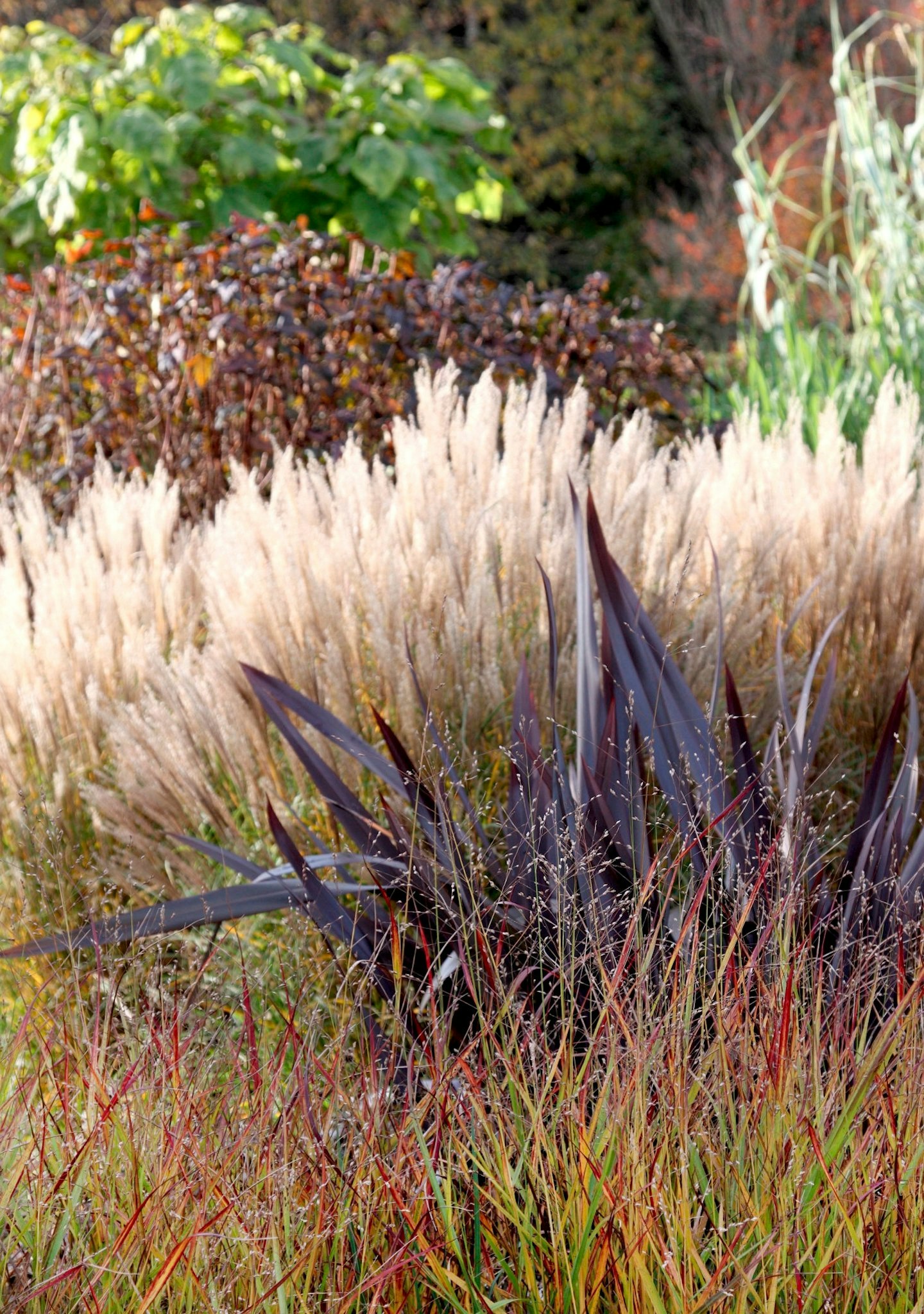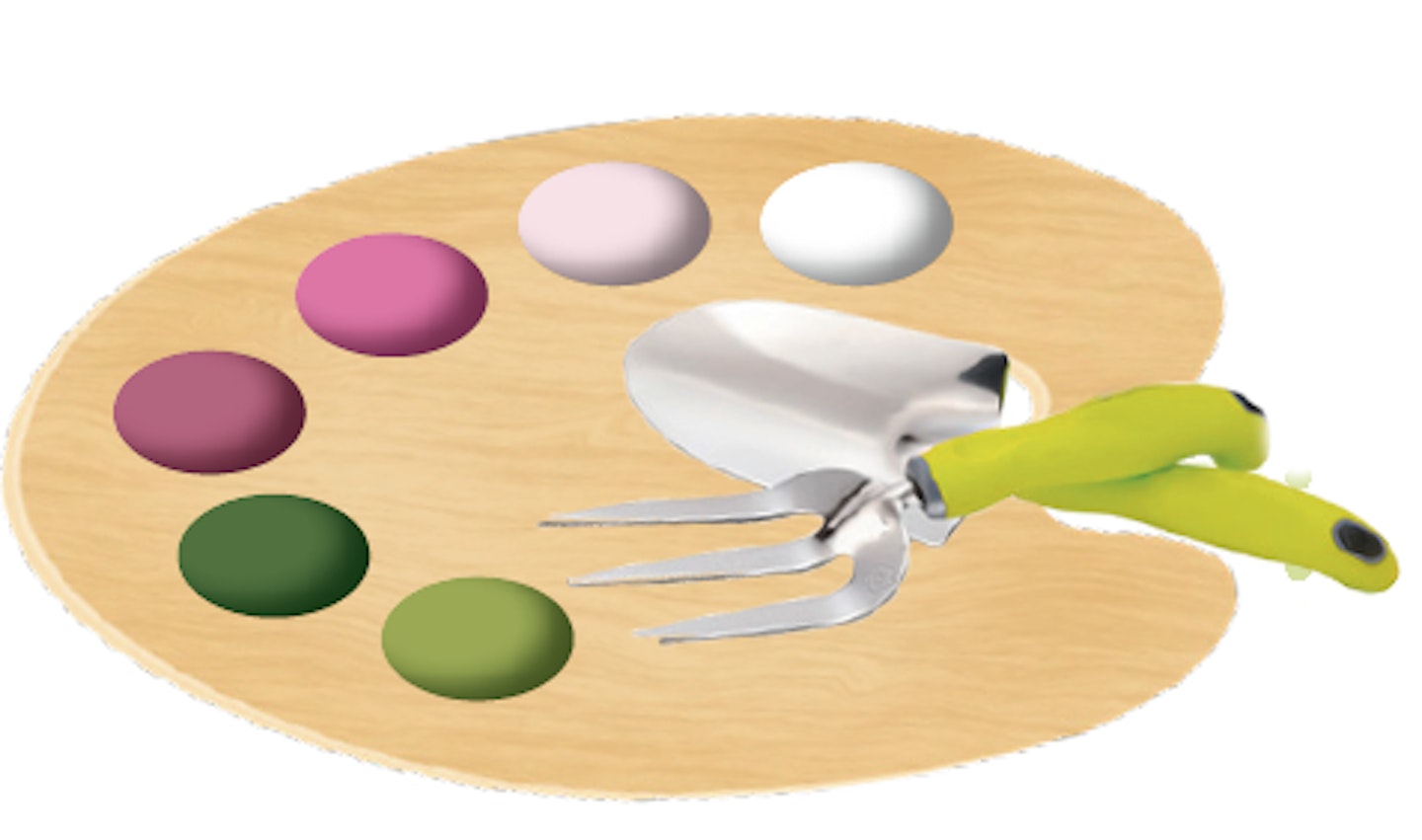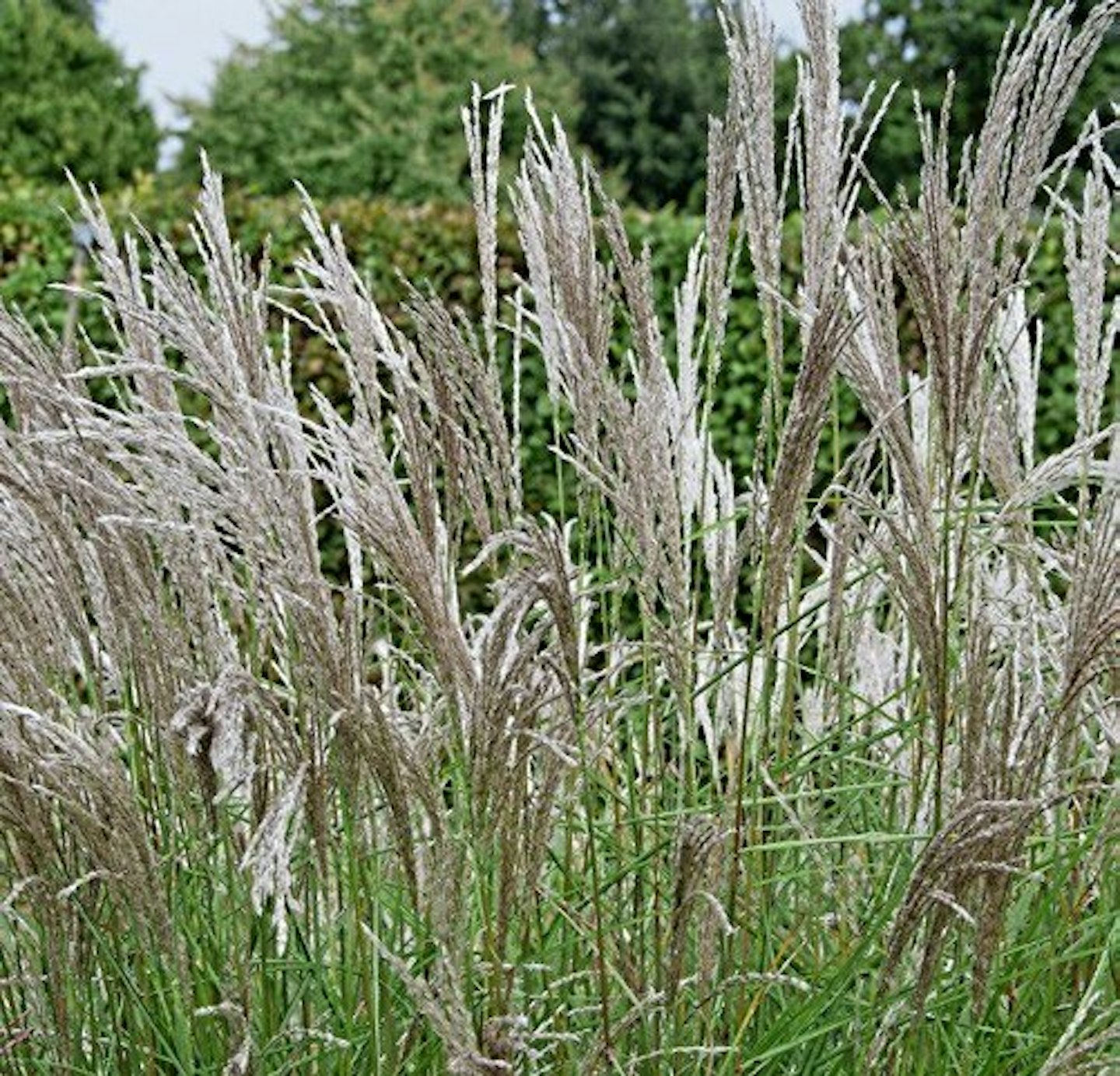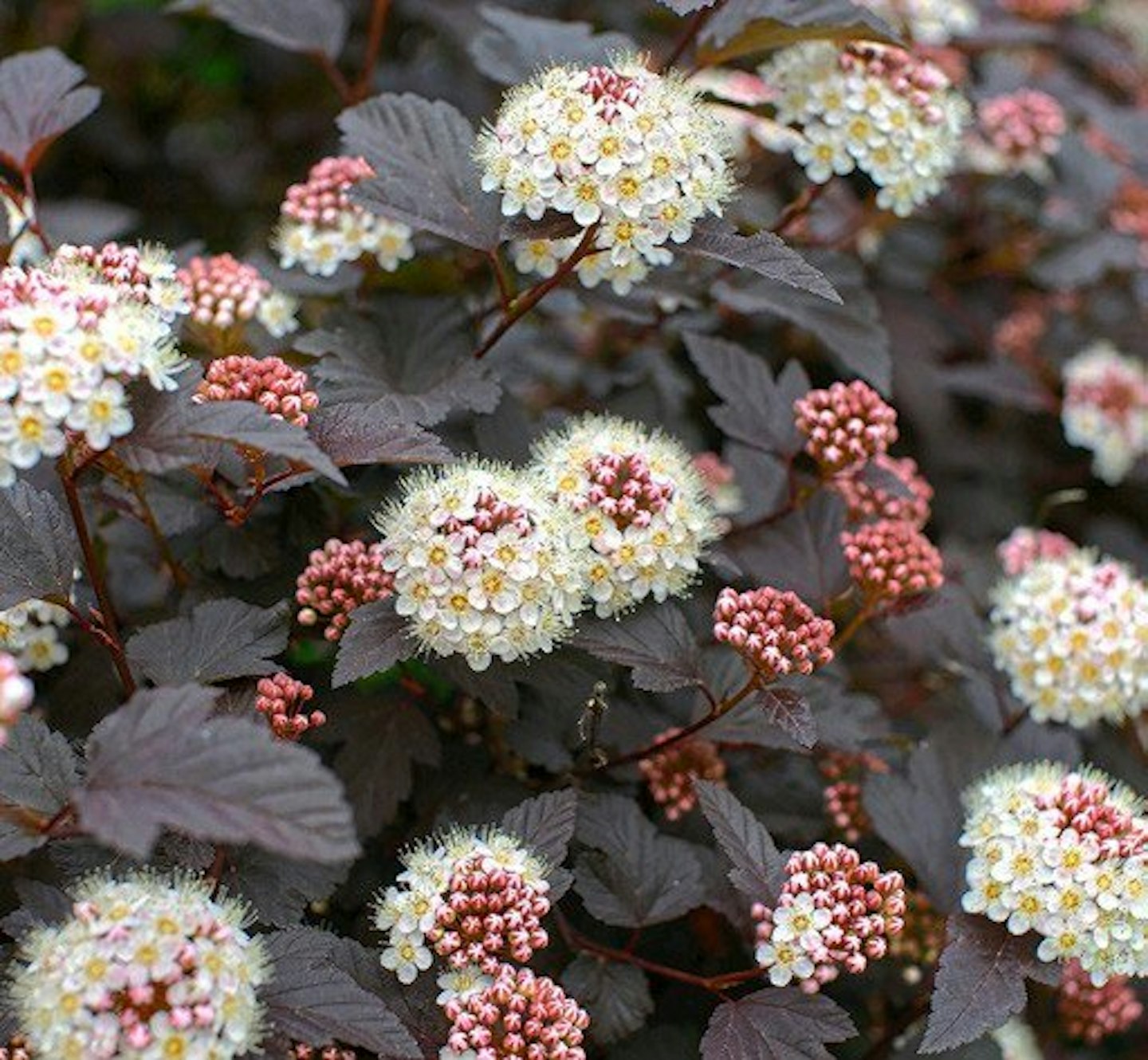Striking black phormiums and physocarpus add drama to the dark-tinted panicum foliage and fluffy miscanthus seed heads
YEAR ROUND COLOUR: NOVEMBER

Flowers might first lure us into gardening, but inevitably it’s the foliage that makes us stay. One minute you’re entranced by your first pelargonium, the next you’re taking notes in RHS Wisley’s Box Alternatives garden; it’s a rite of horticultural passage. This simple grouping at RHS Rosemoor shows what can be achieved without a petal in sight. There’s the lightness and movement of three different grasses, the phormium’s solid black sword leaves, and the physocarpus and catalpa remind us how good a mixed border can be if we widen our ingredient list further.

3 easy steps
STEP 1 - DESIGN YOUR BORDER

STEP 2 - Choose the right plants
PANICUM VIRGATUM ‘SHENANDOAH’
Upright red-tipped foliage on a deciduous grass with hazy flower panicles from summer into autumn. H&S: 90cm.
PHORMIUM ‘PLATT’S BLACK’
Purple-black sword-like leaves on a bold evergreen perennial. Striking red flower spikes may appear in summer, followed by seed heads. H&S: 1.2m

MISCANTHUS SINENSIS ‘KLEINE SILBERSPINNE’
Narrow upright foliage and reddish-silver feathery plums that fade to buff. Deciduous but stands well into winter. H: 1.5m, S60cm.

PHYSOCARPUS OPULIFOLIUS ‘DIABOLO’
Dark purple, maple-like leaves and clusters of white flowers flushed a delicate pink in early summer. Deciduous shrub. H&S: 2.5m.
CATALPA BIGNONIOIDES ‘AUREA’
Large, yellow, heart-shaped leaves and white tubular flowers on mature trees. Excellent pollarded for foliage effect. H: 10m, S: 8m.

ARUNDO DONAX VERSICOLOR
Spectacular tall reed grass with variegated white and green foliage. Half-hardy, it needs protection in winter. H: 2.1m, S: 1.2m.
STEP 3 PLANT YOUR BORDER

This is a chunky planting that you’ll want to get right from the start, with plants requiring serious upper body strength to dig out and move once they’re established. If your chosen area has problems with perennial weeds, no amount of time spent eradicating them will be wasted, even if it means pushing planting back by a year. As you work, add plenty of well-rotted organic matter to encourage a fertile, moist but well-drained soil and mulch the border annually once established.
1 Establish the shrubs
Autumn is the perfect time to establish the key structural shrubs. Dig a hole that’s as deep as their container and twice as wide, improving the soil with further compost as you work. Soak the rootball in a bucket of water for half an hour before planting and make sure its top is level with the soil surface.
Allow the physocarpus a few years to get its roots down, then you can start to prune each year straight after flowering. Removing one in four of the oldest stems back to its base will promote a rolling production of attractive young stems.
Left to its own devices the catalpa grows into an impressive specimen tree, but an alternative way of growing plants is to hard prune it annually back to a framework of low branches. Allow your catalpa to get established for a few years before pruning in early spring. Catalpa are very late into leaf, so don’t panic if new shoots take a while to appear. This hard pruning promotes beautiful large leaves and keeps the plant at a manageable size. Try to give them a sheltered spot away from strong winds because young plants are susceptible to frost.
...or try this
2 Add the grasses
As long as the autumn is still mild and the soil is not waterlogged or frozen then it’s a great time to establish a sweep of panicum and miscanthus.
The panicum will slowly spread over time by its underground rhizomes. Alternatively, lift and divide clumps from mid-spring as you start to see new growth coming through. Make sure they have a sunny site as they tend to topple if things get shady. Leave the top growth to stand all winter before finally cutting it all away in February ready for new growth to come through.
Miscanthus ‘Kleine Silberspinne’ is a justifiably popular cultivar thanks to its narrow upright shape and masses of feathery silver plumes. Like the panicum, leave the top growth to stand over winter, only cutting everything back in late February just before the new growth comes through. Divide established clumps in autumn or spring.
3 Wait for spring for the phormium and arundo
The black phormium leaps out against the pale miscanthus flowers, so keep this in mind when positioning your plant. Young phormiums are more susceptible to the cold, so buying a larger specimen can be worthwhile. Make sure your plant has plenty of space and sunshine as well as good drainage. They’re hardy to about -10C but harsh winter weather can damage foliage.
Each spring, remove any tatty foliage to smarten things up. If really cold spells are forecast then tuck a dry mulch around plants and add a few layers of fleece. Large clumps can be lifted and divided in spring, growing on rooted side shoots in containers in a cold frame for at least a year before planting out.
Arundo donax versicolor is the odd one out in the border because it’s only half-hardy. In very sheltered parts of the country and on well-drained soil it may survive outdoors, but everywhere else you’ll need to lift plants for the winter months and move them into a frost-free greenhouse or conservatory.
Although they’re evergreen, they tend to be quite tatty by the end of winter and it’s best to tidy plants up in early spring.
MAKE THE DISPLAY LAST

WINTER: HEBE ‘RED EDGE’
Small evergreen grey-leaved shrub with foliage edged in red and lilac late summer flowers. H&S: 45cm.

SPRING: EUPHORBIA PASTEURII
An attractive evergreen shrub with attractive domed shape and clusters of yellow flowers in spring. H&S: 1.5m.

SUMMER: HAKONECHLOA MACRA
Emerald hummocks of arching leaves that gain russet tints in autumn; semi-evergreen grass. H&S: 60cm.
AUTUMN: PENNISETUM THUNBERGII ‘RED BUTTONS’
Feathery red summer flowers float above narrow green leaves. H: 60cm, S: 45cm.

